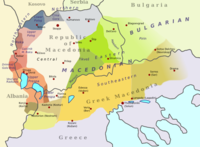
The Vardar Banovina, or Vardar Banate, was a province (banate) of the Kingdom of Yugoslavia between 1929 and 1941.

Kumanovo is a city in North Macedonia and the seat of Kumanovo Municipality, the largest municipality in the country. Kumanovo lies 340 metres above sea level and is surrounded by the Karadag part of Skopska Crna Gora mountain on its western side, Gradištanska mountain on its southern side, and Mangovica and German mountain on the Eastern side. Skopje airport also serves Kumanovo.

The municipalities are the first-order administrative divisions of North Macedonia.
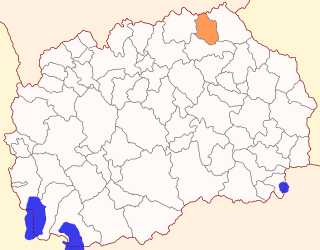
Rankovce is a municipality in the northeastern region of the Republic of North Macedonia. Rankovce is also the name of the town where the municipal seat is found. Rankovce Municipality is part of the Northeastern statistical region.
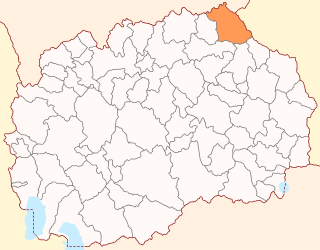
The Kriva Palanka Municipality is in the extreme northeastern part of North Macedonia. Kriva Palanka is the town where the municipal seat is found. The municipality is part of the Northeastern Statistical Region.
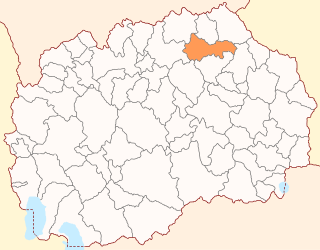
Kratovo is a municipality in eastern part of North Macedonia. Kratovo is also the name of the town where the municipal seat is found. The municipality is part of the Northeastern Statistical Region.

The Serbs are one of the constitutional ethnic groups of North Macedonia, numbering about 24,000 inhabitants.

The Northeastern Statistical Region is one of eight arbitrary statistical regions in North Macedonia. It borders Kosovo and Serbia to the north and Bulgaria to the east, while internally, it borders the Skopje and Eastern statistical regions.
The dialects of Macedonian comprise the Slavic dialects spoken in the Republic of North Macedonia as well as some varieties spoken in the wider geographic region of Macedonia. They are part of the dialect continuum of South Slavic languages that joins Macedonian with Bulgarian to the east and Torlakian to the north into the group of the Eastern South Slavic languages. The precise delimitation between these languages is fleeting and controversial.
The Kumanovo dialect is a member of the eastern subgroup of the Northern group of dialects of Macedonian. It belongs to the so-called Prizren-Timok dialects, also known as Torlakian. The dialect is typical for the northern dialect of Macedonian and is very well known because of the use of some cases, such as the locative case. The Kumanovo dialect is spoken mainly in the city of Kumanovo and the surrounding villages. The dialect is closely related to the neighboring Kriva Palanka dialect. The Kumanovo dialect can be found in literary works, such as the famous play “Lenče Kumanovče” written by Vasil Iljoski in 1928. The Kumanovo dialect is especially popular as a source of humor in the spoken media, whereas the print media tend to favor Western dialect forms for humorous anecdotes and quotations in local news stories. The most significant example where the Kumanovo dialect is used in a humorous way is the festival Tumba Fest.

The Kriva Palanka dialect is a member of the eastern subgroup of the northern group of dialects of Macedonian. This dialect is mainly spoken in the city of Kriva Palanka and surrounding villages.

Antenna 5 Radio Network is a number 1 hits radio station in North Macedonia.

The Corridor VIII is one of the Pan-European corridors. It comprises both road and rail routes. Both commence on the Italian Adriatic coast at Bari or Brindisi, with a ferry crossing to Durrës in Albania. From there the routes cross the southern Balkans into Bulgaria and thence to Varna, on the Bulgarian Black Sea coast. The road corridor follows the route: Tirana/Durrës/Vlorë – Elbasan – Skopje – Pernik – Sofia – Plovdiv – Burgas – Varna. Although as yet incomplete, it is broadly paralleled by the rail route: Durrës/Vlorë-Lin-Radožda-Kičevo-Skopje-Kumanovo-Beljakovtse-Kriva Palanka-Gyueševo-Sofija-Burgas-Varna.

Diocese of Kumanovo and Osogovo is a diocese of the Macedonian Orthodox Church in North Macedonia. It is headed by Metropolitan Josif.
The Kumanovo uprising was an uprising organized by an assembly of chiefs of the districts of Kumanovo, Kriva Palanka, and Kratovo in the Vilayet of Kosovo in 1878. The movement sought to liberate the region from the hands of the Ottoman Empire. Following the Serbian Army's liberation of Niš on 12 January 1877, the rebellion began on 20 January 1878 with guerrilla operations during the army's liberation of Vranje. The rebels received secret aid from the Serbian government. The uprising lasted four months until its suppression by the Ottomans on 20 May, during which the Ottomans retaliated with atrocities on the local population.

The Kumanovo district was a kaza (district) in the Sanjak of Üsküp (Skopje) of the Ottoman Empire. It was formed in 1867, during the reign of Abdülaziz I. It was dissolved in 1912. The district had 3 divisions: Karadak, Kozjak and Ovče Pole.

Severna Makedonia is a book by Yordan Ivanov, a Bulgarian literary historian, archaeologist and folklorist, and contains historical research for the history of the Kyustendil region from antiquity to the Liberation of Bulgaria (1878). The book was published in Sofia in 1906. It consists of 12 chapters. Chapter 1 is about the ancient Pautalia and its surroundings, Chapter 2 is to medieval Velbuzhd. Chapter 3 examines the development of Christianity in North Macedonia. Chapter 4 traces the emergence, history and fall of the Ottoman Empire in the area. Chapter 5, entitled "Kyustendil Sandjak", provides a geographical and historical overview of the cities located in this area: Dupnitsa, Radomir, Vranje, Kriva Palanka, Kratovo, Shtip, Veles, Radovish, Strumitsa, Kochani and Kumanovo. Chapter 6 deals with agriculture and mining in the district. Chapter 7 researches the history of Kyustendil in the 19th century. Chapters 8 and 9 are dedicated to the Kyustendil Diocese in the 19th century. Chapter 10 contains information on the 19th-century schools in Shtip, Kratovo, Kyustendil, etc. Chapter 11 provides information on the ancient and medieval epigraphic monuments. Chapter 12 contains references to the corresponding preceding pages. The book contains 420 pages, with 3 maps, 21 graphics and 18 black and white photo illustrations, a plan, 5 facsimiles and 65 epigraphic monuments from Latin, Greek, Slavic and Ottoman sources and a pointer of personal and geographical names. It has long been a bibliographic rarity.
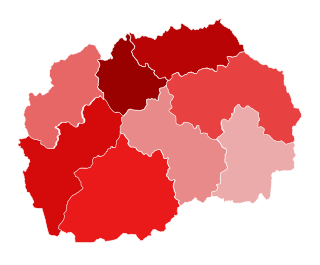
The COVID-19 pandemic in North Macedonia was a part of the ongoing worldwide pandemic of coronavirus disease 2019 caused by severe acute respiratory syndrome coronavirus 2. The virus was confirmed to have reached North Macedonia in February 2020. The initial contagion in the country was mainly connected with the COVID-19 pandemic in Italy as there are circa 70,000 residents of Italy from North Macedonia and resulted in many people returning to North Macedonia, bringing the virus with them. As of 9 July, over 7,000 cases have been confirmed in the country, due to its second wave caused by family reunions during Eid al-Fitr among the Muslim minority and the overall re-opening of the country to organize the parliamentary elections.
